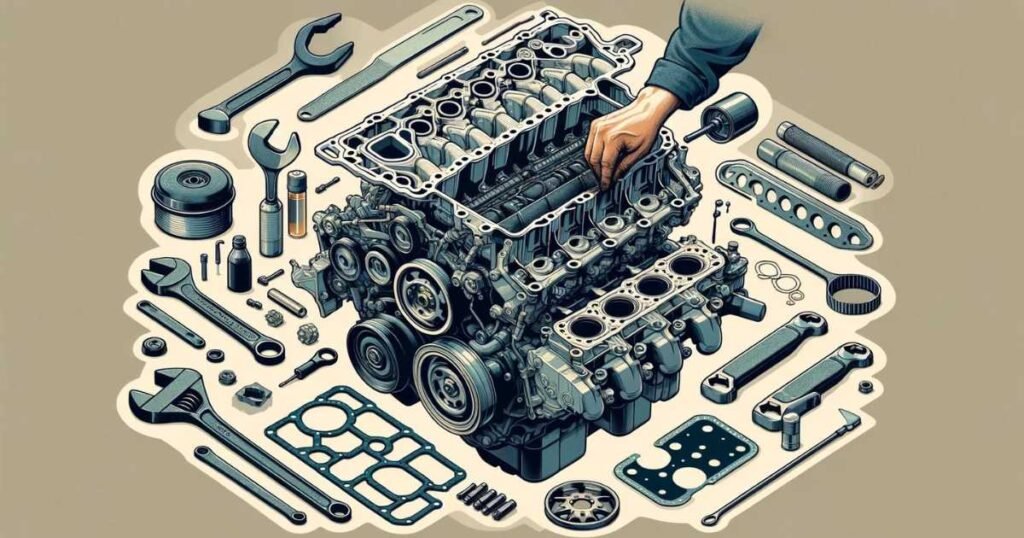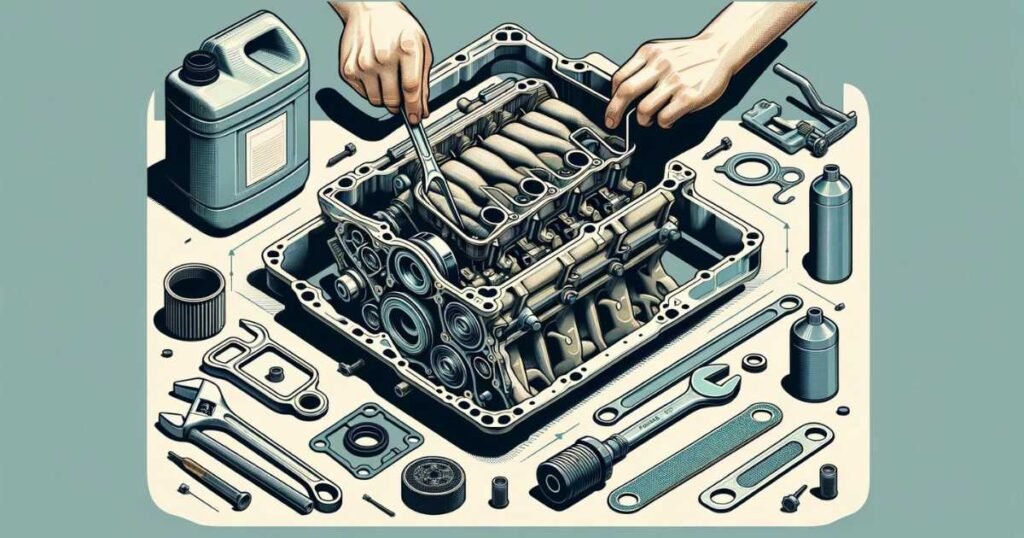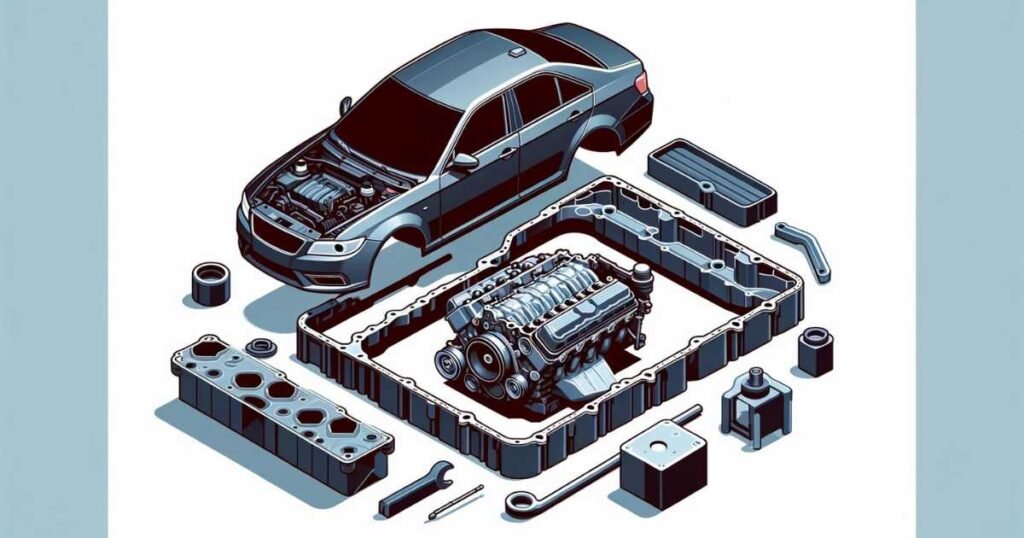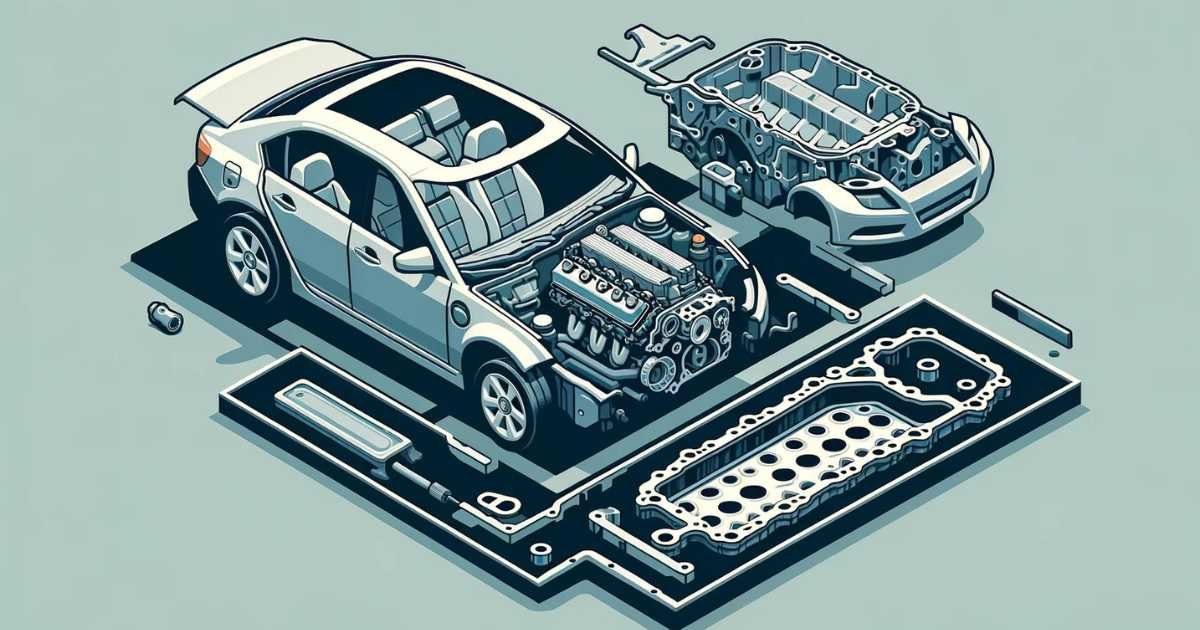The engine oil pan gasket is an important part of your car. It sits between the engine block and the oil pan. This gasket has a big job: it stops oil from leaking and ensures your car’s lubrication system works well. Think of it as a seal that keeps everything running smoothly.
Sometimes, this gasket wears out or gets damaged. When that happens, you might notice oil leaking from your car. This is bad because it can hurt the environment and damage your car’s engine. If you don’t fix it, it can cause big problems.
If you know a bit about cars and have the right tools, you can replace the oil pan gasket. If you are comfortable with car mechanics, you can do this project at home. This will ensure your car stays in good shape and runs well.
In this article:
What are the Signs of a Failing Oil Pan Gasket?
If you think there might be something wrong with your car’s oil pan gasket, there are a few signs you can look for. First, check if a puddle of oil is under your car after you park it. This is a common sign that the oil pan gasket might be leaking. Another thing to notice is the smell. If you smell burning oil, it could mean that oil is dripping onto the hot parts of the engine.
Also, it is good to regularly check the amount of oil in your engine. If the oil level is going down quickly, it might be because of a leak. Keeping an eye out for these signs can help you know if your oil pan gasket needs to be replaced.
What Tools are required to change the oil pan gasket?
Before you start replacing your car’s oil pan gasket, you must have everything you need ready. First, you’ll need a new oil pan gasket that fits your car model. You can check your vehicle’s manual to ensure you get the right one.
Also, since you’ll drain the oil, you’ll need new engine oil and a new filter. Other tools you’ll need include a socket wrench set to help you remove and tighten bolts and an oil pan gasket scraper for removing the old gasket. Have some rags handy to clean up any spills.
A torque wrench is optional but recommended for tightening bolts just right. In some cases, you might also need RTV sealant. And don’t forget a drain pan to catch the old oil when you drain it. Having all these tools and materials ready will make the job easier and smoother.
How can we confirm the source of the leak?
This step is very important. Before you start replacing the oil pan gasket in your car, you must ensure the oil leak is coming from there.
The oil pan is a container at the bottom of your engine that holds the oil. You should clean the area around the oil pan well to check for a leak. You can use a degreaser or engine cleaner for this. After the area is clean, take your car for a short drive.

Then, look at the oil pan area again. If you don’t see any leaks above the oil pan, the oil pan gasket is probably the part that needs fixing. This step ensures you’re fixing the right thing in your car.
11 Effective Steps on How to Change an Oil Pan Gasket?
Replacing the oil pan gasket in your car might sound hard, but you can do it yourself with the right tools and some preparation. It’s important to have all the right supplies.
You will need a replacement oil pan gasket kit for your specific car model, a socket wrench set, a scraper to remove the old gasket, a torque wrench to tighten bolts correctly, and a degreaser to clean the area. Look in your car’s manual for the specific torque specifications—that’s how tight the bolts should be.
Let’s go through the steps quickly.
Here are the steps to replace your oil pan gasket:
- Gather Your Supplies: Get your replacement oil pan gasket kit, socket wrench set, scraper, torque wrench, and degreaser ready.
- Drain the Oil: Find the oil drain plug under the oil pan. Place your drain pan underneath to catch the old oil. Use your socket wrench to open the plug and let all the oil drain out.
- Raise and Secure the Vehicle: Lift your car safely using jack stands. Check your car’s owner’s manual to find the correct places to lift it from.
- Access the Oil Pan: Depending on your car model, you might need to remove parts like skid plates, exhaust components, or the starter motor to reach the oil pan.
- Remove the Oil Pan Bolts: Use your socket wrench to remove all the bolts from the oil pan in a specific sequence, as mentioned in your manual.
- Separate the Oil Pan: Carefully pry the oil pan from the engine block with a scraper, being careful not to damage the sealing surfaces.
- Clean and Inspect Surfaces: Thoroughly clean the mating surfaces of the engine block and oil pan. With a rag and solvent, remove all old gasket material and oil. Check the oil pan for damage.
- Prepare the New Gasket: If recommended, apply a thin bead of RTV sealant to the oil pan edge. Then, position the new gasket on the engine block.
- Reinstall the Oil Pan: Put the oil pan back in place, ensuring the gasket stays aligned. Reinstall and gradually tighten the bolts in the correct sequence to the specified torque.
- Reassemble Components: Put back any components you removed to access the oil pan in the reverse order of removal.
- Replace Engine Oil and Filter: Install a new oil filter and refill the engine with fresh oil as per your owner’s manual recommendations.
Following these steps, you can successfully replace your oil pan gasket and keep your car in great condition! Find a helpful tutorial for Triton F150 5.4L 3v.

How much does it cost to change the oil pan gasket?
Replacing an oil pan gasket can cost different amounts, depending on a few things, like what kind of car you have, how much people charge for work in your area, and how hard it is to do the job. On average, this repair might cost between $400 and $2,000.
The oil pan part itself usually costs between $150 and $500. This price includes a new drain plug and the gasket. The money you pay for someone’s work to do this can change a lot, too. It could be as little as $100 or more than $1,000. This depends on how easy it is to get to the oil pan. Sometimes, the mechanic might even need to lift or take out the engine, making it more expensive.
If you’re considering doing it yourself, it might cost between $20 and $75. But this could be too low for many cars unless your car has a simple and cheap oil pan gasket. If you’re paying a mechanic, the work costs $100 or more, a lot more for some cars, especially if they need extra work to get to the oil pan.
Find out the specific costs for your car and where you live before deciding whether to do it yourself or have a professional do it.

Where can I get oil pan gasket services?
You can replace an oil pan gasket yourself, but it’s okay if you feel better having a professional do it. I need to find out which places are best for this job because it depends on where you live and how much money you want to spend.
If you’re wondering where to get your car fixed, here’s an idea: You can go to franchise auto repair shops. These are significant, well-known places like Midas, Meineke, or Pep Boys. They do oil changes and can usually fix things like oil pan gaskets.
Going to one of these shops can be a good choice because they have extensive experience with different kinds of car repairs.
Key Consideration to remember when oil pan gasket replacement
Changing the oil pan gasket and replacing the engine oil and filter are also brilliant ideas. This makes sense because you have to drain the oil out anyway. Look at a repair manual made just for your car model to do the job right.
This manual provides detailed instructions and tells you how tight the bolts must be (the torque specifications). If you need clarification on any part of the process, it’s important to ask a professional mechanic for help.
They know a lot about cars and can ensure that everything is done safely and correctly. Remember, it’s always better to ask for help than to guess and make a mistake.
Final Thoughts
If you follow these steps and remember to be safe, you can change the oil pan gasket in your car and make sure your engine keeps working well. It’s important to look at the service manual for your vehicle because it has unique information.
The manual contains the exact tightness for the bolts (the torque values) and any extra steps specific to your type of car. By using the manual as your guide, you can do a good job and help your car run smoothly.
Relevant:
How Much Does Meineke Charge for an Oil Change?
What Does A Full-Service Oil Change Consists Of?
What happens if you don’t change your oil?
How Long Does Oil Last in a Car Not Driven?
How Much Does an Oil Change Cost at Midas?
FAQs
Is it hard to change the oil pan gasket?
Changing an oil pan gasket can be moderately complex for an experienced mechanic but challenging for a novice. The difficulty varies depending on the car’s design, the number of bolts, and whether sealant is used. If you’re not confident, it’s wise to consult a professional.
How much does it cost to replace an oil pan gasket?
Replacing an oil pan gasket typically costs between $200 and $500, including labor (between $150 and $400) and parts (gasket $20 to $100, plus engine oil and filter). Costs vary based on location and the type of repair shop.
Can I replace my oil pan myself?
You can replace your oil pan gasket if you’re comfortable with car mechanics and have the necessary tools. If unsure, it’s safer to rely on a professional mechanic.
How often should I replace my oil pan gasket?
There needs to be a set time to replace an oil pan gasket. A good one can last the car’s whole life, especially if you use quality oil. But it might need replacing if it gets old and cracks, wasn’t put in right, your car gets too hot, or the engine shakes a lot.
Can I reuse an oil pan gasket?
Usually, no. Gaskets are made to seal tightly; once used, they don’t work as well again. They might also be damaged. In most cases, it’s best to use a new one for a reliable seal.
What are the signs of a failing oil pan gasket?
The main sign is an oil leak under your car. You might also notice that you have to add oil more often, or there could be a burning oil smell if the leak gets on hot parts of the engine.
Do I need to replace the oil filter when changing the gasket?
Yes, changing the oil filter when you change the gasket is a good idea. The filter keeps the oil clean, and since you’re already draining the oil, it’s a good time to swap it out.
How long does it take to change an oil pan gasket?
A mechanic can do it in 1-2 hours, but it might take longer if you’re doing it yourself, especially if it’s your first time or you run into problems. Make sure you have enough time to do it without rushing.
Can a faulty oil pan gasket cause engine damage?
Yes, a lousy gasket leak can damage your engine. The engine needs oil to work well, and a big leak can cause parts of the engine to get too hot or rub together. If you think your gasket is leaking, check and fix it to avoid damaging your engine.
